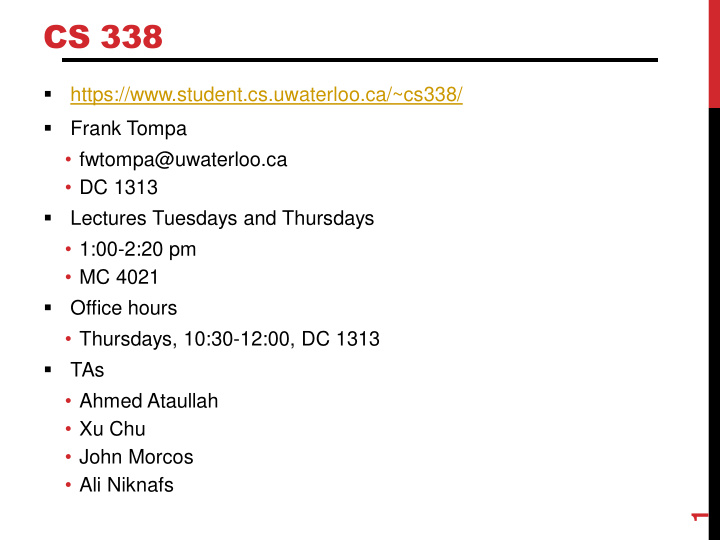



CS 338 https://www.student.cs.uwaterloo.ca/~cs338/ Frank Tompa • fwtompa@uwaterloo.ca • DC 1313 Lectures Tuesdays and Thursdays • 1:00-2:20 pm • MC 4021 Office hours • Thursdays, 10:30-12:00, DC 1313 TAs • Ahmed Ataullah • Xu Chu • John Morcos • Ali Niknafs 1
WHY WOULD I WANT TO PAY ATTENTION IN THIS COURSE? “This course is designed primarily to meet the needs of students who are interested in the business or public sector of the economy. The course presents methods used for the storage, selection, and presentation of data.” • Use database terminology knowledgeably • Understand DB concepts that arise in the workplace • Interact with (direct, understand) IT personnel • Understand technical articles involving DB technology • Discuss DB concepts in a job interview 2
COURSE TOPICS Why do we use databases? • Functionality provided by a Database Management System How do we use a Database Management System? • Relational model, foundational query languages SQL • Transactions, concurrency, and recovery • Security • Distributed databases How do we design a database? • Entity-Relationship (ER) modeling • Accommodating and enforcing constraints 3
RESUMÉ BLURB (UNDER EDUCATION) N.B. Employers will be suspicious or angry if you include the exact same description as other students who have taken the course. You may want to use this as a template, but definitely express it in your own words. CS 338: Computer Applications in Business: Databases • Implemented a database in DB2, defined schemas, developed queries, and performed manipulations in SQL • Transformed a business description into Entity-Relationship diagrams, which were then used to specify a SQL Schema • Applied knowledge of data redundancy, security, backups and recovery, data dependencies and other constraints in database design • Capable of documenting an organization or project's data needs, participating in requirement gathering, and liaising with technical staff (such as DBAs) to deploy systems 4
TEXTBOOK (RECOMMENDED) R. Elmasri and S. Navathe, Fundamentals of Database Systems, 6/E, Addison Wesley, 2010. Sixth, Fifth or (if need be) Fourth Edition • Copies on Reserve in Davis Center Library • Used copies available on campus 5
CLICKERS Active learning lasts longer than passive listening. You will get some credit just for participation and need not be overly concerned about clicker grades. • up to 3% bonus for participating (based on your best 90%) • up to 2% bonus for correct answers (based on your best 75%) Clicker questions allow you to show me what you understand without having to raise your hand and identify yourself. Bookstore ~$42 (return for ~$20) Used ~$?? web>clicker (netbook, smartphone: iOS, Android, Blackberry) ~$10 • 14 day free trial; 180 day license • See http://www.math.uwaterloo.ca/~pkates/CTE/clickers/web-clicker.html Clicker Registration and Information • Be sure to register your clicker here: http://www.student.cs.uwaterloo.ca/~pkates/uw-clicker.html 7
USING YOUR CLICKER Turn it on: Press the ON/OFF button. A solid blue light should appear next to the top Power button . If your clicker came wrapped in packaging, pull out the small plastic tab on the back to activate the batteries. Change the frequency to AC: The instructions on the back of your clicker say Press and hold the ON/OFF button until the top blue Power light flashes. Enter the 2 letter frequency code (AC). The code for each classroom (AC for MC4021) is posted near the podium at the front of the class. When the clicker is turned off it forgets any changes in frequency that have occurred and the clicker frequency is again AA when the clicker is turned on. How do I know if my vote has been received? When the receiver acknowledges a vote, the Vote Status light on the clicker (the third light) will flash green for a moment. If it flashes red instead, then either the voting period hasn't started, or the receiver didn't respond to your vote. In the latter case, change the frequency of your clicker if necessary and vote again. Raise your hand for assistance if you don't see a green response. Can I change my vote/choice? Yes. While the voting process is active, you can vote as often as you like. Only your last (most recent) choice/vote is recorded. 8
EVALUATION Components • Midterm 1: 25% (Thursday, June 6 th , in class) • Midterm 2: 25% (Thursday, July 11 th , in class) • Final: 50% • Clicker participation: bonus factor of 3% • Clicker correctness: bonus factor of 2% Example calculation: • M1=72%, M2=61%, F=68%, Cp=80%, Cc=50% • Average = 67% 69% 70% = Assigned grade 9
ASSIGNMENTS Four assignments throughout term • Sample solutions released on “due date” Goal is to give you practice with material in order to provide self- assessment and guidance Assignment performance not part of evaluation • You need not polish a submission. • You can work alone or with others. • You can seek help from TAs. You will have more trouble learning the material (and passing the course) if you do not attempt the assignments 10
DB2 IBM’s relational database management system For some assignments • Writing SQL, applying DB concepts • Tutorial on website (tutorial in class, May 21) 11
MATERIAL BUILDS ON ITSELF Like other courses in Math Initial lectures focused on terminology and background knowledge Don’t fall behind! “Overwhelming amount of details” 12
Recommend
More recommend